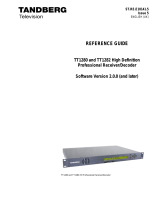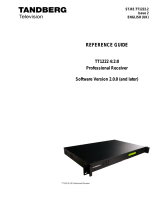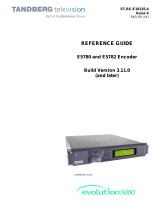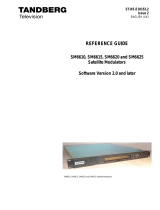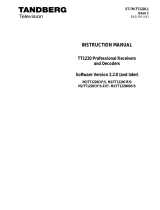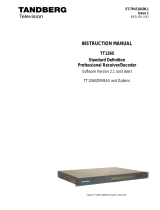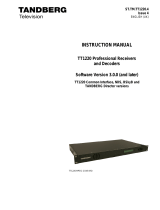Page is loading ...

ST.US.E10141.4
www.tandbergtv.com
ENGLISH (UK)
USER GUIDE
TT1280 and TT1282
HD Professional
Receiver/Decoder
Software Version 2.0.0
(and later)

TT128x High Definition Professional Receiver/Decoder
2
Trademarks
Dolby
®
/ Dolby
®
Digital / AC-3
®
are registered trademarks of Dolby
Laboratories Licensing Corporation.
Customer Services
Europe, Middle East Tel: +44 (0) 23 8048 4455
and Africa: Fax: +44 (0) 23 8048 4467
Americas: Tel: +1 (321) 308 0470
fieldservice-america[email protected]
China: Tel: +86 10 6856 0260 (Beijing)
Tel: +852 2530 3215 (Hong Kong)
fieldservice-asia@tandbergtv.com
Australia/NZ: Tel: +612 9360 2053
fieldservice-austra[email protected]om
Internet Address: http://www.tandbergtv.com
Technical Training
International: Tel: +44 (0) 23 8048 4229
Fax: +44 (0) 23 8048 4467
training@tandbergtv.com
This document and the information contained in
it is the property of TANDBERG Television Ltd
and may be the subject of patents pending and
granted. It must not be used for commercial
purposes nor copied, disclosed, reproduced,
stored in a retrieval system or transmitted in
any form or by any means (electronic,
mechanical, photocopying, recording or
otherwise), whether in whole or in part, without
TANDBERG Television’s prior written agreement.
© 2003 - 2004 TANDBERG Television Ltd.
All rights reserved.
Issue 4 first published in 2004 by:
TANDBERG Television Ltd
Registered Address:
Unit 2 Strategic Park, Comines Way,
Hedge End, Southampton,
Hampshire,
SO30 4DA
United Kingdom
Registered Company Number 03695535

TT128x High Definition Professional Receiver/Decoder
3
Contents
1 Who Should Use This User Guide? .................................................5
1.1 What Equipment is Covered by This User Guide? .................................. 5
1.2 Hardware and Software Options......................................................... 6
2 Installing the Equipment...............................................................7
2.1 Introduction.................................................................................... 7
2.2 Operating Voltage............................................................................ 7
2.3 Power Cable and Earthing ................................................................. 7
2.4 Connecting Up the Basic Receiver....................................................... 8
2.5 Connecting the Receiver to the Power Supply....................................... 9
3 Operating the Equipment From the Front Panel...........................11
3.1 Introduction.................................................................................. 11
3.2 Local Control................................................................................. 11
3.3 Navigation Pushbuttons .................................................................. 11
3.4 Navigating the Menus..................................................................... 12
3.5 LCD Menu Descriptions................................................................... 13
4 Menu Structure...........................................................................15
5 Operating the Equipment Remotely.............................................16
5.1 Introduction.................................................................................. 16
5.2 Remote Ethernet (SNMP) Operation.................................................. 16
6 Basic Unit Set-up ........................................................................16
6.1 Set the Transport Stream Input ....................................................... 16
6.2 Set the Analogue Video Output Options............................................. 17
6.3 Set the Digital Video Output Options................................................. 17
6.4 Set the Transport Stream Output Options.......................................... 17
6.5 Select a Service............................................................................. 18
6.6 Select Video Components................................................................ 18
6.7 Select Audio Components................................................................ 18
List of Figures
Figure 2.1: Rear Panel Connectors............................................................. 8
Figure 3.1: Front Panel Controls and Pushbuttons ...................................... 11
Figure 4.1: Menu Structure..................................................................... 15

TT128x High Definition Professional Receiver/Decoder
4
List of Tables
Table 1.1: Equipment Model Descriptions.................................................... 5
Table 1.2: Hardware Options .................................................................... 6
Table 1.3: Software Options ..................................................................... 6
Table 2.1: Types of Connector...................................................................8
Table 2.2: Fuse Type and Rating ............................................................. 10
Table 3.1: Navigate Mode....................................................................... 12
Table 3.2: Edit Mode.............................................................................. 13
Table 3.3: Selecting a Menu Option.......................................................... 14
Table 3.4: Entering a Menu Value............................................................ 14

TT128x High Definition Professional Receiver/Decoder
5
1 Who Should Use This User Guide?
This User Guide is written for operators/users of the TT1280 and
TT1282 Integrated Receiver/Decoder (IRD) to assist in installation and
operation. The TT1280 and TT1282 are referred to throughout this User
Guide as ‘IRD(s)’ unless there is a specific difference, where they will be
referred to by the model number.
This User Guide is not intended to be a detailed source of information.
This can be found in the Reference Guide companion document which is
issued on CD.
1.1 What Equipment is Covered by This User Guide?
Table 1.1: Equipment Model Descriptions
Model Number Marketing Code Description
TT1280 Common
Interface
TT1280/CIBAS MPEG-2 HD Decoder with
integrated Common Interface CAM
reader, AC mains voltage input.
MPEG 4:2:0 video decode only.
TT1280 Common
Interface
(-48 V version)
TT1280/CIBAS/48V
MPEG-2 HD Decoder with
integrated Common Interface CAM
reader, -48 Vdc voltage input.
MPEG 4:2:0 video decode only.
TT1280 Director
(-48 V version)
TT1280/DIRBAS/48V MPEG-2 HD Decoder with
integrated Director Smartcard
Reader, -48 Vdc voltage input.
MPEG 4:2:0 video decode only.
TT1280 Director TT1280/DIRBAS MPEG-2 HD Decoder with
integrated Director Smartcard
Reader, AC mains voltage input.
MPEG 4:2:0 video decode only.
WARNING
Do not remove the covers of this equipment. Hazardous voltages are
present within this equipment and may be exposed if the covers are
removed. Only TANDBERG Television trained and approved service
engineers are permitted to service this equipment.
CAUTION
Unauthorised maintenance or the use of non-approved replacements may
affect the equipment specification and invalidate any warranties.

TT128x High Definition Professional Receiver/Decoder
6
Model Number Marketing Code Description
TT1282 Common
Interface
TT1282/CIBAS MPEG-2 HD Decoder with
integrated Common Interface CAM
reader, AC mains voltage input.
MPEG 4:2:0 and 4:2:2 video
decode.
TT1282 Director
(-48 V version)
TT1282/DIRBAS/48V MPEG-2 HD Decoder with
integrated Director Smartcard
Reader, -48 Vdc voltage input.
MPEG 4:2:0 and 4:2:2 video
decode.
TT1282 Common
Interface
(-48 V version)
TT1282/CIBAS/48V MPEG-2 HD Decoder with
integrated Common Interface CAM
reader, -48 Vdc voltage input.
MPEG 4:2:0 and 4:2:2 video
decode.
TT1282 Director TT1282/DIRBAS
MPEG-2 HD Decoder with
integrated Director Smartcard
Reader, AC mains voltage input.
MPEG 4:2:0 and 4:2:2 video
decode.
1.2 Hardware and Software Options
See Table 1.2 and Table 1.3 for a list of hardware and software options
available for the IRDs.
Table 1.2: Hardware Options
Marketing Code Description
TT1280/HWO/QPSK 2 input QPSK demodulator input card.
TT1280/HWO/G703 G.703 E3/DS3 input card.
TT1280/HWO/IP IP input card.
TT1280/HWO/HOM 4 input QPSK/8PSK/16QAM demodulator input card
Table 1.3: Software Options
Marketing Code Description
TT1280/SWO/AC3 Dolby Digital decoder.
TT1280/SWO/HSETHER High speed Ethernet data output (data piping).
TT1280/SWO/RAS RAS transport stream descrambling.
TT1280/SWO/RAS2 RAS 2 transport stream descrambling.
TT1280/SWO/DIR Director functionality.

TT128x High Definition Professional Receiver/Decoder
7
2 Installing the Equipment
2.1 Introduction
For best performance and reliability follow the instructions for site
requirements and installation in the Reference Guide and only use
installation accessories recommended by the manufacturers.
2.2 Operating Voltage
AC Models
AC models are fitted with a wide-ranging power supply. It is suitable for
supply voltages of 100-120 Vac -10% +6% or 220-240 Vac -10% +6%
at 50/60 Hz nominal.
-48 Vdc Models
Only models TT1280/CIBAS/48V, TT1280/DIRBAS/48V,
TT1282/CIBAS/48V and TT1282/DIRBAS/48V use a dc power supply.
See Table 2.2 for fuse information and also the Reference Guide for a
full power supply specification.
2.3 Power Cable and Earthing
Check that the power cable is suitable for the country in which the
Receiver is to be used.
CAUTION
This product should be operated only from the type of power source
indicated on the marking label. If you are not sure of the type of power
supply to your business, consult a qualified electrical engineer or your local
power company.
NOTE
Refer to the Reference Guide for details of the colour codes used on
the mains leads.

TT128x High Definition Professional Receiver/Decoder
8
2.4 Connecting Up the Basic Receiver
Always use the specified cables supplied for signal integrity and
compliance with EMC requirements (see the Reference Guide).
Only those connectors used are labelled in Figure 2.1 and described in
Table 2.1.
Figure 2.1: Rear Panel Connectors
Table 2.1: Types of Connector
Type of Connector Description
Video Out
A 15-way D-type connector provides an RGB/HV (SVGA)
or YPrPb interface. The video output format is selectable
via the front panel.
AUDIO 1 A 9-way male D-type connector provides both analogue
and digital outputs simultaneously
AUDIO 2 A 9-way male D-type connector provides both analogue
and digital outputs simultaneously
FRAME SYNC
A 75 W BNC connector provides a frame lock mechanism
for the output analogue and digital video. The frame
sync input signal shall be a composite burst signal.
ASI/HDSDI
OUT 1 and 2
Video
Out
Audio
1 and 2
Frame
Sync
ASI/SMPTE
310 In
10/100BaseT
Alarm
Technical
Earth
RS-232/RS422
Data Out
WARNINGS
1. The Technical Earth is not a Protective earth for electric shock
protection.
2. This unit must be correctly earthed through the moulded plug
supplied. If the local mains supply does not have an earth
conductor do not connect the unit. Contact Customer Services for
advice.
3. Before connecting the unit to the supply, check the supply
requirements in Annex B of the Reference Guide.

TT128x High Definition Professional Receiver/Decoder
9
Type of Connector Description
ASI/HDSDI OUT 1
A 75 W BNC connector provides either an MPEG
transport stream output interface or serial digital video
output. ASI or HDSDI output format is selectable via the
front panel.
ASI/HDSDI OUT 2
A 75 W BNC connector provides either an MPEG
transport stream output interface or serial digital video
output. ASI or HDSDI output format is selectable via the
front panel.
ASI/SMPTE 310 IN
A 75 W BNC connector provides an MPEG transport
stream input interface. ASI or SSI (SMPTE 310) input
format is selectable via the front panel.
10/100BaseT
An 8-way RJ-45 connector provides a 10/100BaseT
Ethernet interface for external control and monitoring.
Also optionally provides a High Speed Ethernet data
output
Alarm Relay
If required, connect an external status monitoring device
to the Alarm connector. A 9-way, D-type male connector
provides an alarm relay interface which can be used to
send a signal to remote equipment.
RS-232/RS-422
Data Out
RS-232 data is available on the Base Board.
Technical Earth Connect the Receiver's Technical earth to a suitable
point.
2.5 Connecting the Receiver to the Power Supply
NOTE
Refer to the Reference Guide for all power supply, fuse, safety, EMC
information and operating conditions.
WARNINGS
1. Do not overload wall outlets and extension cords as this can result
in a risk of fire or electric shock.
2. As no mains switch is fitted to this unit, ensure the local power
supply is switched OFF before connecting the supply cord.
3. The Receiver is not fitted with an on/off switch. Ensure that the
socket-outlet is installed near the equipment so that it is easily
accessible. Failure to isolate the equipment properly may cause a
safety hazard.

TT128x High Definition Professional Receiver/Decoder
10
Connect the Receiver to the power supply as follows:
> Power Supply
Ensure the power supply is isolated and switched off.
> Receiver
Ensure the correct fuse type and rating has been fitted to both the
equipment and the power cable.
> Supply Cord
Connect the lead to the Receiver input connector and then to the
power supply. Switch on the power supply.
Table 2.2: Fuse Type and Rating
Power Supply Fuse Type and Rating
100-120 Vac / 220-240 Vac IEC/EN 60127-2 Sheet 5
Bussmann S505/Littelfuse 215
2 A 250 V T HBC
-48 V
Bussmann S505/Littelfuse 215
5 A 250 V T HBC

TT128x High Definition Professional Receiver/Decoder
11
3 Operating the Equipment From the Front Panel
3.1 Introduction
The front panel display and keypad may be used to configure, control
and monitor the Receiver when an external control system is not used.
3.2 Local Control
At power-on the Receiver runs through a boot sequence (boot time is
approximately 15 seconds). The Service menu is displayed (Menu 3).
3.3 Navigation Pushbuttons
Figure 3.1: Front Panel Controls and Pushbuttons
LCD dis
p
la
y
Save
Edit U
p
Down
Left
Ri
g
ht
Alarm LED
Lock LED

TT128x High Definition Professional Receiver/Decoder
12
3.4 Navigating the Menus
Operating the IRD from the Front Panel is via two operating modes:
Navigate Mode and Edit Mode.
3.4.1 Navigate Mode
Navigate mode allows the user to move between menus and pages
within menus (editing the left display area).
Table 3.1: Navigate Mode
Action Result
Up Pushbutton Pressed Go to page given by uplink of current page,
obtain and display current data.
Down Pushbutton Pressed Go to page given by down link of current page,
obtain and display current data.
Left Pushbutton Pressed
Go to page given by left link of current page,
obtain and display current data.
Right Pushbutton Pressed
Go to page given by right link of current page,
obtain and display current data.
Edit Pushbutton Pressed Enter Edit mode at current page (if permitted
else no effect).
Save Pushbutton Pressed No effect.
Pushbutton LEDs will be updated to indicate which pushbutton presses
are still valid as each navigation pushbutton press event is processed.
For example, a lit Up pushbutton LED indicates there are pages above
the current one.
3.4.2 Edit Mode
Edit mode edits the right display area and allows the user to alter
control parameters that define the IRD behaviour. To enter Edit mode
press the Edit pushbutton when on a page containing an editable
control parameter and the front panel is the controlling user interface.
Edit may be entered on some special pages at all times, for example on
the page defining the controlling user interface.
The Front Panel returns to Navigate mode when Edit is pressed again
(abort edit with no save) or when Save is pressed (save modified
parameter values).

TT128x High Definition Professional Receiver/Decoder
13
Table 3.2: Edit Mode
Action Result
Up Pushbutton Pressed Increases value of current edit parameter by one
unit.
Down Pushbutton Pressed Decreases value of current edit parameter by one
unit.
Left Pushbutton Pressed
Moves cursor one edit parameter/parameter digit
left (making that the current edit parameter).
Right Pushbutton Pressed Moves cursor one edit parameter/parameter digit
right (making that the current edit parameter).
Edit Pushbutton Pressed Aborts edit (no save/action of any modified
parameters) and returns to Navigate mode,
obtain and display current data.
Save Pushbutton Pressed Save/action new parameter values and returns to
Navigate mode, obtain and display current data.
Pushbutton LEDs are updated to indicate which pushbutton presses are
still valid as each edit pushbutton press event is processed. For
example, when the Left pushbutton LED is lit it indicates there are
additional editable parameters to the left of the current cursor position.
There is a maximum idle period of five minutes when Edit mode will
time out and return to Navigate mode.
3.5 LCD Menu Descriptions
Detailed LCD menu descriptions are given in the Reference Guide. This
User Guide concentrates on describing the use of the menus for local
operation.
3.5.1 Selecting a Menu Option
Some items shown in the right display area of the front panel LCD
display have a set number of options. An example of this is the VIDEO
TEST PATTERN (Menu 3.1.6) which has a number of preset Video Test
Patterns associated with it. Use the steps in Table 3.3 as a general
guide to selecting an option.

TT128x High Definition Professional Receiver/Decoder
14
Table 3.3: Selecting a Menu Option
Step Action Result
1 Select the menu and display the
required selection.
Normally there is only one
selectable item. If there is more
than one, use the Right and
Left pushbuttons as described in
Table 3.4.
2 Press Edit on the front panel. The Save button comes on to
show that the new option can be
stored.
3
Use the arrow pushbuttons to step
through the options.
This action scrolls through the
options in a continuous loop.
4
Press Save to store the option or
press Edit to cancel the selection
and return to the source menu.
3.5.2 Entering a Menu Value
Some items shown in the right display area of the front panel LCD
display have a user-entered value. An example of this is the IP Address
(Menu 7.1.3) in which the unit’s Network address has to be entered.
Use the following steps as a general guide to entering a value.
Table 3.4: Entering a Menu Value
Step Action Result
1 Select the menu and display the
required selection.
2 Press Edit on the front panel. The Save button comes on to
show that the new value can be
stored.
3
Use the Right or Left pushbutton to
move the cursor to the required
digit.
Each pushbutton has a built-in
LED that turns on if the
pushbutton function is
appropriate to the displayed
information.
4
Change the value by using the arrow
pushbuttons.
5 Press Save to store the option.

TT128x High Definition Professional Receiver/Decoder
15
4 Menu Structure
Section C.9
Section C.6
Section C.4
Section C.5
4. Conditional Access
Menu
5. TS Output Menu
5.1 Connector 1/2
7. System Menu
2. Input Menu
(QPSK, G.703 or IP or HOM)
1. Presets Menu
TT1280 Initialising
SWITCH ON
Boot Screen
1 Preset Menu
2 Input Menu
3 Service Menu
4 Conditional Access Menu
5 TS Output Menu
6 Alarms Menu
7 Systems Menu
7 Date/Time
7.1 Setup Operating Mode
7.1.1 LCD Contrast
7.1.2 Serial Remote Protocol
7.1.3 IP Address
7.1.3.1 Subnet Mask
7.1.3.2 Gateway Address
7.1.4 Restore System Defaults
7.1.5 Service Hunt Mode
7.1.6 SI Mode
7.1.7 Customisation Key
7.2 IRD Details Electronic Serial No.
7.2.1 Software Version
7.2.1.1 Decoder Version
7.2.3 Hardware Version
7.2.4 PLD Version
7.2.5 Temperature
7.3 System Restart
1 Presets Select
1.1 Presets Save
2.1 Select Input (ASI/SSI)
2.2 SMPTE 310
2.3 G.703 PDH Rate/DS3 Framing Option
2.3.1 G.703 Status
2.3.1.1 Randomisation/Stuffing
2.3.1.2 Signal Status
2.3.2 Reed Solomon
2.3.3 Interleaver
2.3.4 Signal Level
3.1 Video Selection
3.1.1 Resolution/Frame Rate
3.1.2 Coding Mode/Profile
3.1.3 GOP/Pixel/Aspect Ratio
3.1.4 Rate Buffer Level/Bitrate
3.1.5 Fail Mode
3.1.6 Test pattern
3.1.7 Framesync
3.1.7.1 Offset
3.1.8 Video Delay
3.1.9 Output Mode
3.1.10 Trisync Mode
3.1.11 Embedded Audio Channel
3.1.11.1 Embedded Audio PIDs
3.2 Audio 1 Selection
3.2.1 Sampling Rate/Bitrate
3.2.2 Rate Buffer Level
3.2.3 Delay Adjustment
3.2.4 Digital Output/Routing
3.2.5 Clipping Level
3.2.6 AC3 Downmix Method
3.3 Audio 2 Selection
3.3.1 Sampling Rate/Bitrate
3.3.2 Rate Buffer Level
3.3.3 Delay Adjustment
3.3.4 Digital Output/Routing
3.3.5 Clipping Level
3.3.6 AC3 Downmix Method
3.5 Async Data Selection
3.4.1 Bitrate/Status
3.6 Sync Data Selection
3.5.1 Bitrate/Status
3.7 Ethernet Data
3.6.1 Bitrate/Status
3.6.2 Diagnostics
3.6.3 Gateway Setup
3.8 VBI Selection
3.7.1 VITC Insertion
3.7.2 Closed Caps
3.9 PCR Selection
3.10 Network ID/Original Network
3. Service Selection Menu
4.1 RAS Mode/RAS Key Setup
4.2 Signal Protection Status
4.3 Common Interface Status/Director Status
1
4.4 BISS Mode/Key Setup
4.4.1 BISS User ID One Setup
4.4.2 BISS User ID Two Setup
Section C.8
6. Alarms Menu
6.1 Transport Stream alarm setup
6.2 Video alarm setup
6.3 Audio 1 alarm setup
6.4 Audio 2 alarm setup
6.5 MER alarm setup
6.6 BER alarm setup
6.7 Temperature alarm setup
Section C.7
1
Dependent on model type
3.1.6.1 Test Pattern Standard
3.4 Dolby Selection
7.2.6 Model Number
7.2.2 Firmware Version
Figure 4.1: Menu Structure

TT128x High Definition Professional Receiver/Decoder
16
5 Operating the Equipment Remotely
5.1 Introduction
When an external control system is used the Receiver may be
configured, controlled and monitored remotely.
5.2 Remote Ethernet (SNMP) Operation
If the Receiver is to be controlled via its Ethernet interface the unit's IP
address and associated parameters must be set in the relevant menus.
Firstly, the unit’s IP address should be set (Menu 7.1.3). Then the unit
subnet mask should be set (Menu 7.1.3.1) and if the controlling device
is on a separate network accessed through a gateway router then the
gateway IP address should be set (Menu 7.1.3.2). Finally the operating
mode should be set to “NETWORK (SNMP)” (Menu 7.1). The SNMP MIB
for the IRD is available from TANDBERG Television.
6 Basic Unit Set-up
6.1 Set the Transport Stream Input
Navigate to the Input Menu (Menu 2.1/2.2) and select the transport
stream input source required. This menu always has options ASI or
SMPTE 310. Dependent upon what additional input option cards have
been fitted, G.703, QPSK or IP may also be selected.
ASI/SSI Input
No other parameters need be set.
G.703 Input
> Set the Reed-Solomon (Menu 2.3.2)
> Set the Interleaver (Menu 2.3.3)

TT128x High Definition Professional Receiver/Decoder
17
HOM/QPSK Input
> Select the RF Input connector (Menu 2.3)
> Set the LNB frequency (Menu 2.3.2)
> Satellite frequency (Menu 2.3.2.1)
> Symbol rate (Menu 2.3.2.2)
> Modulation FEC (Menu 2.3.2.3)
> LNB power (Menu 2.3.2.4)
> LNB 22 kHz (Menu 2.3.2.5)
> Frequency search range (Menu 2.3.2.6)
IP Input
> Receive UDP port number (Menu 2.3.2)
> Input IP address (Menu 2.3.2.1)
> Input subnet mask (Menu 2.3.2.2)
> Input gateway address (Menu 2.3.2.3)
> Input multicast IP address (Menu 2.3.2.4)
6.2 Set the Analogue Video Output Options
Select RGB or YUV video output to match the requirements of the video
monitor being used (Menu 3.1.9).
Navigate to the Trisync Mode Menu (Menu 3.1.10) and select the mode
that matches the requirements of the video monitor being used – either
“ON GREEN”, “ON ALL” or “NONE”.
6.3 Set the Digital Video Output Options
Navigate to the HD SDI output selection menu (Menu 5.1) and select
the HD SDI to be output on either Connector 1 or Connector 2 or both.
6.4 Set the Transport Stream Output Options
Navigate to the ASI output selection menu (Menu 5.1) and select the
transport stream output (ASI) to be output on either Connector 1 or
Connector 2 or both.

TT128x High Definition Professional Receiver/Decoder
18
6.5 Select a Service
Navigate to the Service Selection menu (Menu 3). For single service
transport streams the service should be selected and displayed along
with the service ID. For fully compliant DVB or ATSC transport streams
the service name should also be displayed.
For multiple service transport streams press Edit and, using the Up and
Down pushbuttons, scroll through the service name list. Then press
Save to select the required service.
Alternatively, use the Right pushbutton to move the cursor to the
service ID field and press Edit. Enter the required service ID using the
Up and Down pushbuttons for each digit of the service ID.
6.6 Select Video Components
Navigate to the Video Component Selection menu (Menu 3.1). This
menu displays the number of video elementary streams present in the
current service.
To change the currently selected component, press Edit and, using the
Up and Down pushbuttons, scroll through the component list. Then
press Save to select the required component.
Alternatively, use the Right pushbutton to move the cursor to the PID
field and press Edit. Enter the required component PID using the Up
and Down pushbuttons for each digit of the PID.
6.7 Select Audio Components
Navigate to the Audio Selection menus (Menu 3.2 and 3.3).
To change the currently selected component, press Edit and, using the
Up and Down pushbuttons, scroll through the component list. Then
press Save to select the required component.
Alternatively, use the Right pushbutton to move the cursor to the PID
field and press Edit. Enter the required component PID using the Up
and Down pushbuttons for each digit of the PID.
Move the cursor to the audio standard field and press Edit. Using the
Up and Down pushbuttons select the required audio standard type and
then press Save.
/
